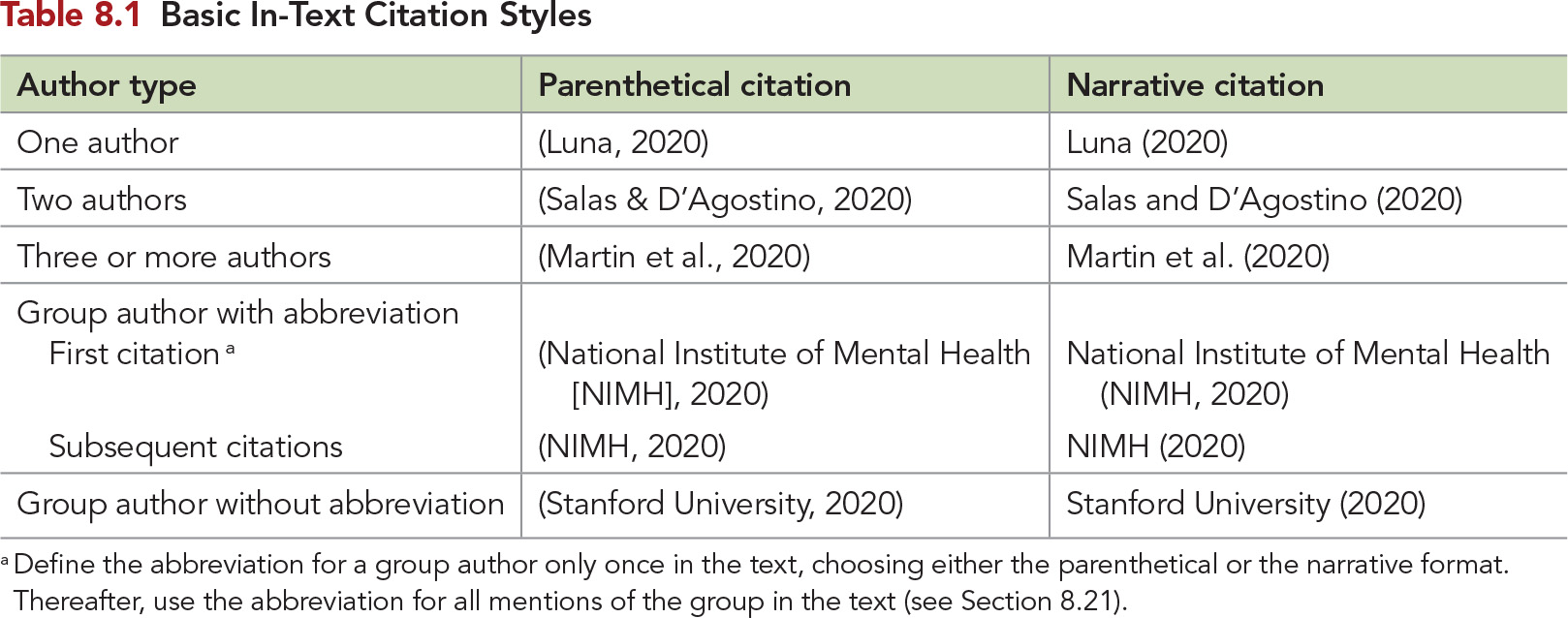To credit the researchers who influenced the manuscript and to help readers better understand each contribution and locate each one if they choose, APA style features the author-date method of citation. (See section 8.10 onward in the Publication Manual (7th edition) for details.)
Each source (e.g., article or book) used in a paper is cited with two parts: an in-text citation within the paper and a corresponding reference entry. The in-text citation briefly identifies the piece and enables readers to identify it in the reference list at the end of the paper.
There are two types of in-text citations: parenthetical and narrative. The parenthetical method incorporates the author name and publication date within parentheses and the narrative method works the author name and publication date into the parts of the sentence.
Parenthetical: Surveys conducted during the last decade showed that Spanish literature falls neatly into two time periods, ancient and modern (Cantrell, 2018).
Narrative: Cantrell (2018) conducted numerous surveys showing that Spanish literature falls neatly into two time periods, ancient and modern.
If quoting directly using either method of in-text citation, be sure to include the page number (page is abbreviated as "p." / multiple pages as "pp.") or paragraph number to help readers find the reference.
Parenthetical: (Cantrell, 2018, pp. 3-6)
See the boxes below for more specific information.
When directly quoting an author's words, APA style requires a parenthetical including the three components of author, year, page number (page abbreviated as "p." or "pp." for multiple pages).
For works that do not use pagination, use any approach that will get readers to the source. These may include a section name, a paragraph number (or a combination of both), a heading, a table number, slide number or other marker.
Parenthetical: "You may remember me from such hits as Christmas Ape and Christmas Ape Goes to Summer Camp" (McClure, 2018, p.352).
When a work has one author, always cite the author's name every time the reference occurs in text.
Narrative: Quimby (2000) compared monorail systems
Narrative: In 2000 Quimby compared monorail systems
Parenthetical: In a recent study of monorail systems (Quimby, 2000)
When a work has two authors, always cite both names every time the reference occurs in text.
Narrative: As Smithers and Skinner (1952) demonstrated in their landmark study, hairy-nosed wombats are monogamous.
Parenthetical: Studies of female wombats raised in captivity attack males before allowing them to mate (Nahasapeemapetilon & Ormand, 2015).
When a work has three, or more authors, cite the name of the first author plus "et.al" (an abbreviation for "and others") in every citation, unless doing so would create ambiguity.
Narrative: Studies conducted by Adillon, et al. (2018) revealed that the trustworthiness of an article is not related to its quality but is dependent on the correct information within the article.
Parenthetical: The trustworthiness of an article is not related to its quality but is dependent on the correct information within the article (Adillon, et al., 2018)
When the in-text citations with three or more authors shorten to the same form, write out as many names as needed to distinguish the references and abbreviate the rest of the names to "et.al." Do this to avoid ambiguity.
Two works with the following authors:
Hibbert, Rivera, Monroe, Foster, Zweig, and Colossus (2017)
Hibbert, Rivera, Da Silva, Zweig, Colossus, and Foster (2017)
Are cited as follows to avoid ambiguity:
Hibbert, Rivera, Monroe, et al. (2017)
Hibbert, Rivera, Da Silva, et al. (2017)
Authors with same surname - S. Duff (1959) and R. Duff (1989) also found
Two or more works by the same author(s) - Past research (Jones & Muntz, 1981, 1983)
Works by same authors with same publication date - Several studies (Brockman & Pie, 1978a, 1979b)
Works by different authors are listed in the same parentheses in alphabetical order - Several studies (Frink & Stu, 2018; Moleman, 1988; Zuckerman, 2015)
Specific part of a source - (Pennycandy, 1980, chap. 35)
For letters, conversations, etc. (Cite only in text.) - S. Stanky (personal communication, November 1, 2000)
General mentions of websites, periodicals, software and apps where no specific information is used (Cite only in text.) -SurveyMonkey (https://surveymonkey.com/)

